We already know that all disruption (and profitable innovation) is caused by changes in product-market fit. And, we know that there are only three ways that product-market fit can change.
So how can companies actually create the change that drives disruption and profit? There must be millions of ways, right?
Wrong. There are only five ways to change product-market fit.
Since product-market fit measures how well the demands of a market segment are met by the a product, it stands to reason that to change product-market fit companies need to change either their products or the market. And that is exactly the case: three of the five moves are Product Moves: innovating to increase your product’s Q-PMF and ΔV. The other two are Market Moves: changing the market so that your current product is a better fit.
Product Plays: The 3 Types of Product Innovation
Although they frequently occur in combination, there are only three types of product innovation:
- Technology Innovation
- Design Innovation
- Business Model Innovation
Each of these has its own characteristics. Knowing how to tell which one you’re creating (or facing, in the case of market leaders encountering disruption) is critical to developing attack and defense strategies that are likely to succeed. Our definitions of these types of innovation differ somewhat from the usual colloquial meaning, so let’s dig into them.
TECHNOLOGY INNOVATIONTechnology Innovation is the creation of a new platform based on a unique scientific principle, on which firms manufacture products to serve customers’ needs in a particular market.
This is a narrow definition ((Our definition follows that of Ashish Sood and Gerard J. Tellis in their 2011 paper Demystifying Disruption: A New Model for Understanding and Predicting Disruptive Technologies. This paper is a fascinating analysis of technology innovations. They deliberately exclude Design (what they call “Design and Component” innovation) and Business Model innovation from their analysis, which eliminates the vast majority of real world innovation. But for Technology innovation they reach some interesting conclusions about what kinds of companies tend to succeed and how they do it.)). Technology Innovations are rare – and their impact is frequently enormous. Here are some examples of technology innovation:
Each of the above examples used a new scientific principle to provide the core values that the product delivers. In our nomenclature, the introduction of flourescent light fixtures to a world where the only electric light came from incandescent bulbs is an example of Technology Innovation. However, the later introduction of the compact flourescent lamp is an example of a Design Innovation. For sure the CFL required technological improvements, but not the introduction of a whole new scientific principle of light production.
Technology innovations can have a devastating impact on products based on the displaced technologies — and in many cases, on the companies who made them. Technology Innovation can produce “scorched earth” disruption: market disruption that completely destroys an industry.
This is especially true when the incumbent market leaders have a large capital investment in the old technology. For example, Kodak lead the world in photographic film & processing for decades. It was a photography company, but it was really a chemical company. The transition to digital imaging was truly catastrophic for Kodak for two reasons: first, it demolished the value of their massive investment in chemical imaging, their core competency. Second, by taking consumables (film, paper, processing) out of the photography market, it just plain made being in the photography business less profitable. Even if Kodak had better executed the transition and was today’s leading digital camera brand, the transition to digital would still have been a disaster. The margins and market size for cameras are just not as good as they were for film and film processing. In 1996, Kodak’s revenues were $16 Billion. Nikon’s were $3 Billion. Kodak was not going to flourish by becoming Nikon.
Could Kodak have made better decisions than they did? Sure (see this article by Chunka Mui for a summary) – but they were also facing scorched earth disruption, where even the best options are not great. And, of course, now the digital camera makers are facing their own disruption (this time powered by Design Innovation) as mobile phone cameras eat away at the core camera value dimensions.
But not not every Technology Innovation creates a scorched earth outcome. Magnetic tape did not eliminate vinyl records. Compact flourescent bulbs did not eliminate incandescent lamps (although LED might). The microwave oven certainly introduced a new scientific principle into cooking, but there are still plenty of gas and electric ovens out there.
The key question for companies to ask when they are facing or creating disruption through Technology Innovation is: how does the new technology perform in existing value dimensions, and what changes to the customer value model does it introduce? If you understand that, you know what you’re dealing with and can make the right strategic choices.
If you are a current market leader sitting on a cash cow like Kodak was in 1996, we have some good news for you: Technology Innovations are rare! But the bad news is that the vast majority of product innovations do not involve a new scientific principle and are examples of Design Innovation and/or Business Model innovation. So let’s move on.
Design Innovation is a big category, and includes:
You might be saying, “Hang on a second – isn’t Apple a technology company, and isn’t the iPhone the most lauded technology innovation in recent memory? Why is the iPhone not a Technology Innovation?”
Was the iPhone built on a new scientific principle? No — but the iPhone is a marvel of Design Innovation for many reasons. First, it brought together advances in hardware, software, and components (such as Gorilla Glass) in a very effective way. Second, it is a great example of an innovation that initially competed not on primary or secondary value dimensions, but instead introduced brand new value dimensions that had previously not existed (if you’re not clear what we’re talking about here, check out Product-Market Fit: “The Only Thing That Matters” and The 3 Modes of PMF Change). Third, it’s impact was magnified significantly by a Business Model Innovation that was its close partner: iTunes.
As we said above, Technology Innovation is rare. Design Innovation is not rare — it is ubiquitous. Almost all of what is colloquially thought of as technology innovation is really Design Innovation. For example, the category includes all software development and the majority of new or improved products. Some sensationally effective Design Innovations are borderline trivial in themselves, and their power comes from new business models that they enable.
So let’s talk about Business Model Innovation.
Many of the most significant innovations of the past 15 years have been Business Model innovations. Back in 1999 when people were saying “The Internet Changes Everything” what they meant was that old business models, ALL old business models, were about to be disrupted. And they were pretty much right. Welcome to the Age of Hyper-Innovation.
Arguably the greatest innovation of the internet era, in terms of financial impact, is Google AdWords. Before AdWords, most businesses that wanted to advertise on the internet had to invest $10,000 or more to design and place banner ads. With AdWords, you could get started with a few words about your product and pocket change. In 2012, AdWords generated over $40 Billion in revenue for Google. AdWords did not really change what internet advertising was, but it did change how it was sold, bought, priced, and delivered.
The same could be said for iTunes (music) and Netflix (movies). Netflix is an interesting example for another reason. First, it annihilated its primary competitor Blockbuster with the postal mail delivery system for DVDs that it pioneered and perfected.
We need to pause here for this video:
Historic ‘Blockbuster’ Store Offers Glimpse Of How Movies Were Rented In The Past
Later, Netflix disrupted itself with another Business Model Innovation.
Market Plays: The 2 Types of Market Innovation
Attaining Product-Market fit means fitting your product to the market. Right? Right?
Right. Most of the time. But sometimes you can fit the market to your product. There are two ways to do this: make people like your product better, or find new people to sell to who already like your product better. Let’s look at the first market play:
The prosecution submits:
In 1984 Nike could have made a perfectly good basketball shoe — but no one would have wanted it. Nike was a running shoe company, which was a tough thing to be as the running craze of the 1970s waned in the 80s. They were total unknowns in basketball. Who was going to buy basketball shoes from them?
Nike needed to find a new path. They needed a new reason for people to love their product — and they found it. (Although the very problem they had almost kept them from finding the solution. According to Jack McCallum, Michael Jordan initially refused to even talk to Nike since he had never worn them and knew nothing about them, and only went to the meeting because his mother made him ((Now we know who the mother of invention is))).
Nike was able to create two powerful changes with the introduction of the Air Jordan and their long association with Michael Jordan. First, they really did add a new property to their product: their product became “the shoe that Michael wears.” Then, through spectacular advertising they made that property more and more important to their market. Here’s how they took a product with very low Q-PMF and turned it into something with very high Q-PMF:
- Introduce a new value dimension into the market: “The Shoe that Michael Jordan Wears”
- Ensure that no competitors can attain any performance in that dimension
- Make that dimension as important as possible to your target market
With a great contract and relationship with Jordan, and with amazing basketball performance by Jordan and advertising performance by Nike, they were able to achieve all three. And they did it very, very well. So well that more than 10 years after his basketball career ended, Michael Jordan still earns over $60 million per year in royalties from Nike. That’s the value of high Q-PMF.
The story of Crisco is another amazing example of going from no Q-PMF to very high Q-PMF by changing what your market thinks about the product, not the product itself. NPR’s Planet Money team does a great job of breaking down the story. It’s worth a listen (It’s just 5 minutes long. As you listen, ask yourself – what value dimensions were at work here?).
Now let’s move on to:
If you can’t make a product that your customers like better by using Technology, Design, or Business Model Innovation, and you can’t make your customers like your existing product better by Changing Attitudes, then what do you do? Find other people to sell to!
Switch Segments is the last play in the Innovator’s playbook. The good news for Segment Switchers is that geographical, language, and distribution barriers are falling fast. If there’s a market segment out there that prefers your product, there’s a good chance you can find them and sell to them.
Here’s an example from my own experience. In 2005 I became the EVP of Technology & Operations at Nimblefish, a San Francisco startup and a pioneer in cross-channel marketing automation.  Our product let marketers build amazing campaigns that integrated email, personalized websites, and digitally printed direct mail, all with content specifically targeted to the individual customer. You might remember the buzz-phrase “1:1 marketing” which was circulating at that time – that’s what we were really good at, in big campaigns with lots online and offline components and millions of variations in messaging.
Our product let marketers build amazing campaigns that integrated email, personalized websites, and digitally printed direct mail, all with content specifically targeted to the individual customer. You might remember the buzz-phrase “1:1 marketing” which was circulating at that time – that’s what we were really good at, in big campaigns with lots online and offline components and millions of variations in messaging.
And, the product created great results for customers. We helped Apple with their launch of the Power Macintosh G5, and generated 11 times the return of their typical direct marketing campaign. Our campaigns cost more to run, about two to three times as much as a typical direct mail / email campaign at that time, but the ROI was huge. Invest 3 times more, get back 11 times more.
So you would think that Apple would use Nimblefish for every campaign from that day forward, right? Well, there was a catch. These campaigns also required more work from the marketers. In order to generate millions of variations of messaging, we needed detailed information about the desires and pain points of a dozen or more market micro-segments, and we needed the Apple marketing people to provide it for us. This was more work than they were used to doing for a campaign. So even though the results were huge, the team was exhausted. Their basic reaction was, “That was fantastic! But let’s not do it again – at least not now. We need a break!”
We knew our style of campaign worked best for “considered purchase” products, where the buyer needs a lot of information before buying. So we sold to companies like Apple, HP, and Adobe who used our technology for new product launches. And while the product-market fit was very high in some dimensions, the weakness was the amount of work marketers had to put into creating the targeted messaging verses the relatively short duration of a typical product launch campaign.
So, what could we do? Since the power of the campaigns was largely due to the precision targeting of the messaging, we really did need the marketers to provide detailed information about their customer segments. We could make product changes that would make that a little better, but it was not going away. But what if we could find a customer who was more willing to put in the work, maybe because the payoff was bigger? Could we find a new set of customers where our current product, with no changes, had higher Q-PMF?
Yes, we found them. The first of these new customers was Lowe’s, the giant home improvement retailer, who used our product to help people who were remodeling their kitchens. The products and messaging for kitchen remodels don’t change much from year to year, and people don’t remodel their kitchens very often. That meant that the messaging for the campaign could be used for years and years with minimal updates. So the return on the work they did setting up the messaging was much higher.
Lowes was followed by many others, as diverse as Invisalign and Marriot Vacation Club. But what they all had in common was that they were selling a considered purchase product, the product did not change very often, and customers did not buy frequently. You don’t remodel your kitchen, or get cosmetic braces, or buy a timeshare vacation home very often – maybe only once in your life. So it is fine for the company to use essentially the same messaging for years, especially if it is precisely targeted to each customer.
This change had a massive impact for Nimblefish. We went from an average deal size of about $75,000 to over $1,000,000. Each deal produced recurring revenue for years. Our company grew by 10x and we were acquired in 2010.
Although we used it successfully at Nimblefish, segment switching is rather rare as a stand-alone strategy. It is not uncommon for companies to move or expand into new markets, but they often need to use one of the other moves in the Innovator’s Playbook in order to make it happen. Generally speaking, some kind of Technology, Design, or Business Model innovation is also required in order to succeed in the new segment.
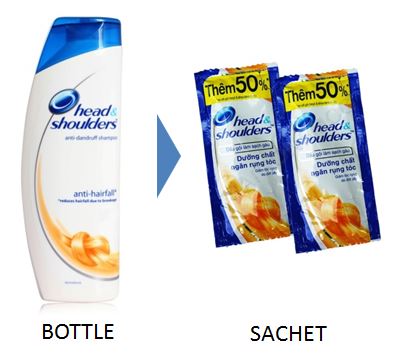 The strategy known as “Sachet Marketing” is an example. It is a very simple Business Model Innovation that opened up huge new markets for some consumer packaged goods companies.
The strategy known as “Sachet Marketing” is an example. It is a very simple Business Model Innovation that opened up huge new markets for some consumer packaged goods companies.
Here’s how: Two-thirds (66%) of the world’s population makes less than $1,500 per year. So many people can’t afford to invest in a 3-month supply of shampoo, for example.
Innovative micro-selling methods, which were pioneered in India in the 1980s and subsequently spread to new consumers in developing countries including China, India, Philippines, Mexico and Brazil, created new smaller and more affordable packages called “sachets.” This opened up a new market of eager consumers. This is an example of a simple business model change (put the product in smaller packages) driving expansion into a market for which the original product (big bottles) was a poor fit.
Just 5 Moves
Innovators, these 5 moves are all you got. There are no other ways to create or change product-market fit. They can and frequently are used in combination, but there’s nothing else in the tool box.
When you’re creating your innovation strategy, whether you’re on offense creating a disruptive new product or on defense protecting an established business, you’ll increase your odds of success by understanding the 5 moves in the Innovator’s Playbook.
NEXT: Table Stakes & Over Fit
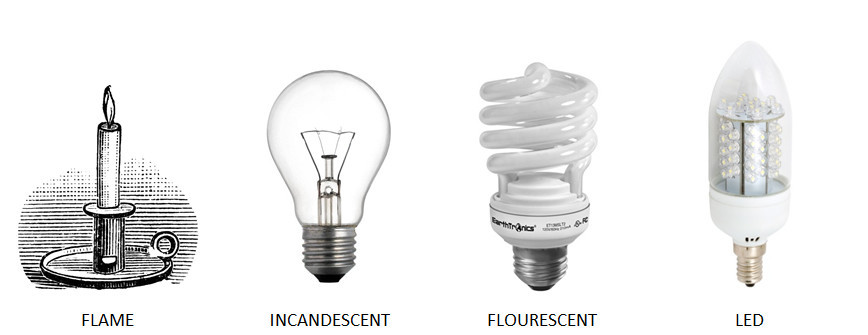
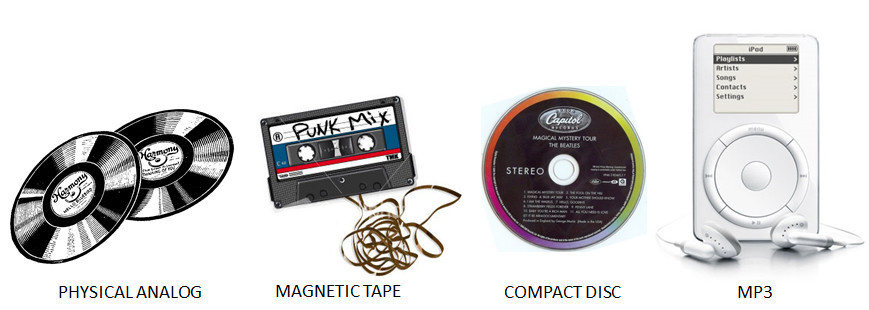

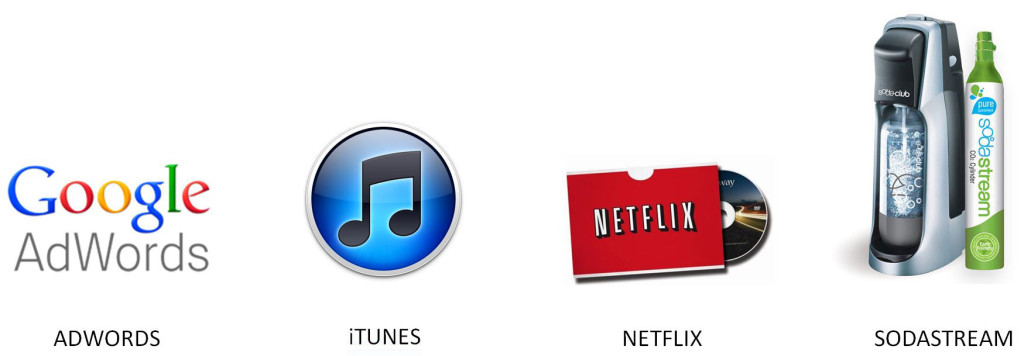
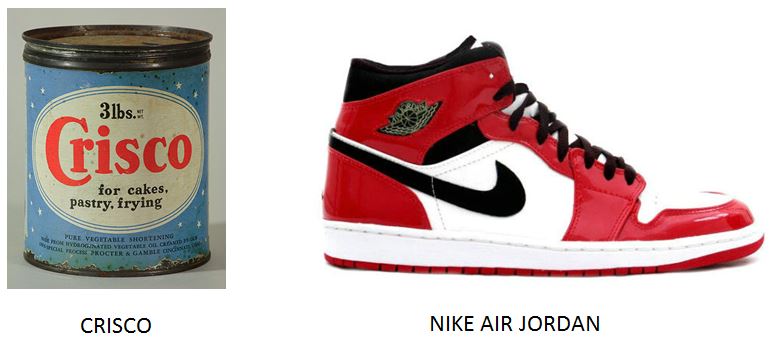
typo: “he had never worn them and new nothing about them” -> knew
Would it be interesting to explore some of the risks in the Jordan relationship? The risk of tying your product to a person: Tiger Woods, Lance Armstrong, Michael Phelps… seems like it can be a risky way to boost ΔV.